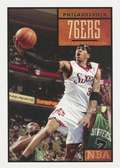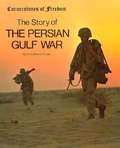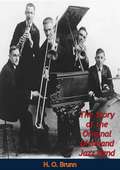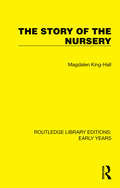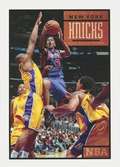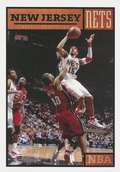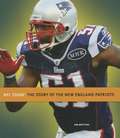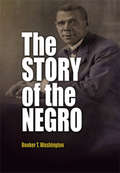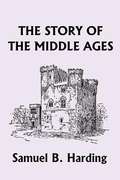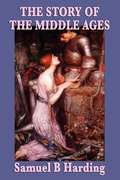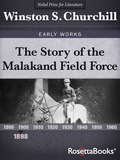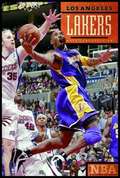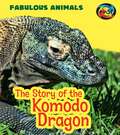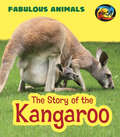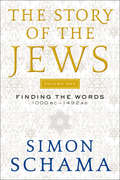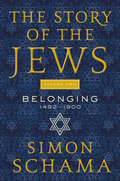- Table View
- List View
The Story of the Philadelphia 76ers (The NBA--A History of Hoops)
by Nate LeboutillierLearn the team's origins, stars, and greatest moments.
The Story of the Persian Gulf War (Cornerstones of Freedom)
by Leila Merrell FosterExamines the causes and events of the Persian Gulf War that followed Iraq's invasion of Kuwait in 1990.
The Story of the Panama Canal (Cornerstones of Freedom)
by R. Conrad SteinA history of the building of one of the world's great engineering feats.
The Story of the Original Dixieland Jazz Band
by H. O. BrunnIt was the five young men who called themselves The Original Dixieland Jazz Band who raised jazz from being a curious, local, and peculiarly Negro phenomenon into the greatest popular artform in history. In 1916 they swept Chicago off its feet. In 1917 they took New York by storm. For the first time jazz became fashionable. People crowded into Reisenwehr’s Restaurant where they played. They were in constant demand for shows and charity performances. They accompanied Sophie Tucker and appeared on the same bill as Caruso.In March 1917 they made the first jazz record and their fame flew across the whole continent. The record was the biggest seller in the R.C.A. catalogue, passing the magic million and easily outstripping the records of Caruso and Sousa’s Band which were the current popular idols.But, not content with America as their platform, they also became the first group to export the new music. And London, too, was caught up in the exciting rhythm and wild, savage, haunting gaiety of jazz. For more than a year they played to packed houses. They gave a command performance for King George V. They were the sensation of the Victory Ball to celebrate the signing of the Treaty of Versailles.When the band broke up for the first time in 1924, partly torn by inner dissension, partly frustrated by the wave of indignation against the frenzied enthusiasm of their supporters (in 1922 jazz was banned after midnight in New York City), they had firmly established themselves as the top entertainment group in the United States, and they had blazed a trail to success which all could follow. They had proved that jazz was not merely a folk-music which could only be appreciated by Negroes, but the expression, in a particularly exhilarating form, of something which was an essential part of human nature.“Here at last is the book that tells the truth about how jazz music really began.”—THE GRAMOPHONE -
The Story of the Nursery (Routledge Library Editions: Early Years)
by Magdalen King-HallOriginally published in 1958, this reconstruction of the lives of young children of nursery age is an excursion into the past, from the Middle Ages to the opening years of the twentieth century. It tells of the methods, often extraordinary to our ideas, by which they were brought up from babyhood to about seven years old, their clothes, diet, the fearsome remedies that were inflicted on them in illness, their toys, games, books and first steps in education. It shows how the pristine simplicity of the child’s nature, which hardly alters throughout the centuries, was moulded by the pressure of the adult society around them into some semblance of the accepted contemporary type. This story of the nursery is not only about young children, but about their parents too. There are parents in it who are stern, harsh, even cruel, and many more loving and careful ones; but one thing strikes us in these parents of former times: there is an air of unassailable confidence and certainty about them that the modern parent, versed in child psychology, would find it hard to achieve. As one seventeenth-century worthy put it, ‘For that which always happens in a concerne so universall as breeding children must needs be provided for by a traditionell method of proceeding.’
The Story of the Nineteenth Amendment (Cornerstones of Freedom)
by R. Conrad SteinA history of the movement to grant women the right to vote in the United States, which culminated in the nineteenth amendment to the Constitution in 1920 that permitted them to do so.
The Story of the New York Stock Exchange (Cornerstones of Freedom)
by Zachary KentDescribes the origins, significant historical landmarks, and recent events of the New York Stock Exchange.
The Story of the New York Knicks (The NBA--A History of Hoops)
by Nate LeboutillierLearn the team's origins, stars, and greatest moments through photos and lively text.
The Story of the New Jersey Nets (The NBA--A History of Hoops)
by Nate LeboutillierLearn the team's origins, stars, and greatest moments through photos and lively text.
The Story of the New England Patriots
by Jim Whiting"The history of the National Football League's New England Patriots, surveying the franchise's biggest stars and most memorable moments from its inaugural season in 1960 to today"--Provided by publisher.
The Story of the Negro
by Booker T. WashingtonThe Story of the Negro is a history of Americans of African descent before and after slavery. Originally produced in two volumes, and published here for the first time in one paperback volume, the first part covers Africa and the history of slavery in the United States while the second part carries the history from the Civil War to the first part of the twentieth century. Booker T. Washington was born into slavery, worked menial jobs in order to acquire an education, and became the most important voice of African American interests beginning in the latter part of the nineteenth century.The Story of the Negro is valuable in part because it is full of significant information taken from hundreds of obscure sources that would be nearly impossible to assemble today. For instance, Washington discusses the rise of African American comedy with names, places, and dates; elsewhere he traces the growth and spread of African American home ownership and independent businesses in the United States; and his discussion of slavery is informed by his own life. Washington wanted African Americans to understand and embrace their heritage, not be ashamed of it. He explains, as an example, the role of music in the lives of the slaves and then notes how, nearly a generation later, many African Americans were "embarrassed" by this music and did not want to learn traditional songs. Washington is able to reflect on the first fifty years of his life embracing a range of experiences from share-cropping to dinner at the White House. It is just this autobiographical element that makes the volume compelling.Washington, with his indefatigable optimism, worked his entire life to achieve equality for African Americans through practical means. Founder of the first business association (the National Negro Business League), leader of the Tuskeegee Institute, where George Washington Carver conducted research, and supporter of numerous social programs designed to improve the welfare of African Americans, Washington was considered during his lifetime the spokesperson for African Americans by white society, particularly those in positions of power. This led to criticism from within the African American community, most notably from W. E. B. Du Bois, who considered Washington too accommodating of the white majority, but it took Washington's farsightedness to recognize that the immediate concerns of education, employment, and self-reflection were necessary to achieve the ultimate goal of racial equality.
The Story of the Mormons: From the Date of their Origin to the Year 1901
by William Alexander LinnThe object is to present a consecutive history of the Mormons, from the day of their origin to 1901, as a secular, rather than religious, narrative.
The Story of the Montgomery Bus Boycott (Cornerstones of Freedom)
by R. Conrad SteinTraces the events in the Montgomery, Alabama, bus boycott which began in December, 1955, and changed the course of the civil rights movement.
The Story of the Monitor and the Merrimac (Cornerstones of Freedom)
by R. Conrad SteinAn account of the naval duel fought in the Chesapeake Bay between the opposing ironclads of the North and the South.
The Story of the Middle Ages
by Samuel B. HardingRelates the history of the Middle Ages simply, directly, and entertainingly. The material is well-arranged and the selection of topics is excellent. Special attention is given to presenting the life of the people-peasant, noble, and court. A unique and valuable book. Suitable for ages 11 and up.
The Story of the Middle Ages
by Samuel B. HardingThis Unique and valuable book tells the history of the Middle Ages in an understandable and entertaining fashion. It helps the reader to understand the influence of the Middle Ages on Modern times. We follow Harding as he guides us through the rise of the Christian church, Feudalism, Charlemagne, the Crusades, and the Hundred Years' War. Harding also takes great care to describe the daily lives of peasants, noble, and clergymen.
The Story of the Mayflower Compact
by Norman RichardsThe most important documents in world history like the Mayflower Compact were written by ordinary people with extraordinary ideas.
The Story of the Mandkind
by Hendrik Willem Van LoonFirst published in 1921, The Story of Mankind has charmed generations of readers of all ages with its warmth, simplicity, and wisdom. Beginning with the origins of human life and sweeping forward to illuminate all of history, Hendrik van Loon's incomparable prose enlivens the characters and events of every age. His unique ability to convey history as a fascinating tale of adventure has endeared the book to countless readers and has accorded it a unique place in publishing history.
The Story of the Malakand Field Force: An Episode Of Frontier War (Winston S. Churchill Early Works)
by Winston S. ChurchillIn this early work, the future Prime Minister recounts his observations as a young war correspondent in late 19th century British Colonial India. In 1897, Winston Churchill was a 22-year-old subaltern in the 4th Hussars, stationed in Bangalore. Seeking military distinction, he talked his way onto the Malakand Field Force to battle indigenous tribes after meeting the commander, Sir Bindon Blood, at a social engagement. There were no openings for junior officers—but Churchill convinced the commander to allow him to come along as a war correspondent. And thus a great career was born. This book shows the determination and spirit that would later mature into the indomitable personality of Winston Churchill in his prime. While not as polished as his later work, it is still elegantly crafted--and shows a brash willingness to criticize military leaders, including Lord Kitchener himself. It is one of Churchill's more rare works; until a new edition was published in 1990, it had been out of print in English since 1916.
The Story of the Los Angeles Lakers (The NBA--A History of Hoops)
by Nate LeboutillierLearn the team's origins, stars, and greatest moments through photos and lively text.
The Story of the Komodo Dragon
by Anita GaneriThis series describes animals that were once thought to be myths or hoaxes. This book looks at the komodo dragon: the first time it was reported to the Western world, the public and scientific community's reaction to it, the search for evidence, how the animal was finally recognised as a real species, and its current status today. There is also some information about the komodo dragon's life and what makes it special or different.
The Story of the Kangaroo
by Anita GaneriThis series describes animals that were once thought to be myths or hoaxes. This book looks at the kangaroo: the first time it was reported to the Western world, the public and scientific community’s reaction to it, the search for evidence, how the animal was finally recognised as a real species, and its current status today. There is also some information about the kangaroo’s life and what makes it special or different.
The Story of the Johnstown Flood (Cornerstones of Freedom)
by R. Conrad SteinDescribes the devastating tidal wave that hit the city of Johnstown and several Pennsylvania villages on Memorial Day, 1889, when the South Fork Dam above the city collapsed as a result of spring rains.
The Story of the Jews: Finding the Words 1000 BC-1492 AD (Story of the Jews #1)
by Simon SchamaIn this magnificently illustrated cultural history--the tie-in to the pbs and bbc series The Story of the Jews--simon schama details the story of the jewish people, tracing their experience across three millennia, from their beginnings as an ancient tribal people to the opening of the new world in 1492It is a story like no other: an epic of endurance in the face of destruction, of creativity in the face of oppression, joy amidst grief, the affirmation of life despite the steepest of odds.It spans the millennia and the continents--from India to Andalusia and from the bazaars of Cairo to the streets of Oxford. It takes you to unimagined places: to a Jewish kingdom in the mountains of southern Arabia; a Syrian synagogue glowing with radiant wall paintings; the palm groves of the Jewish dead in the Roman catacombs. And its voices ring loud and clear, from the severities and ecstasies of the Bible writers to the love poems of wine bibbers in a garden in Muslim Spain.In The Story of the Jews, the Talmud burns in the streets of Paris, massed gibbets hang over the streets of medieval London, a Majorcan illuminator redraws the world; candles are lit, chants are sung, mules are packed, ships loaded with gems and spices founder at sea.And a great story unfolds. Not--as often imagined--of a culture apart, but of a Jewish world immersed in and imprinted by the peoples among whom they have dwelled, from the Egyptians to the Greeks, from the Arabs to the Christians.Which makes the story of the Jews everyone's story, too.
The Story of the Jews Volume Two: 1492-1900
by Simon SchamaIn the second of two volumes of this magnificently illustrated cultural history—the tie-in to the PBS and BBC series The Story of the Jews—Simon Schama details the story of the Jewish people, spanning from their expulsion from Spain during the Inquisition across six hundred years to the present day.It is a story like no other: an epic of endurance against destruction, of creativity in the face of oppression, joy amidst grief, the affirmation of life against the steepest of odds.It spans the centuries and the continents—from the Iberian Peninsula and the collapse of “the golden age” to the shtetls of Russia to the dusty streets of infant Hollywood. Its voices ring loud and clear, from the philosophical musings of Spinoza to the poetry written on slips of paper in concentration camps. Within these pages, the Enlightenment unfolds, a great diaspora transforms a country, a Viennese psychiatrist forever changes the conception of the human mind.And a great story unfolds. Not—as often imagined—of a people apart, but of a Jewish culture immersed in and imprinted by the peoples among whom they have dwelled. Which, as Simon Schama so brilliantly demonstrates, makes the story of the Jews everyone’s story, too.The Story of the Jews Volume 2 features 24 pages of color photos, numerous maps, and printed endpapers.
